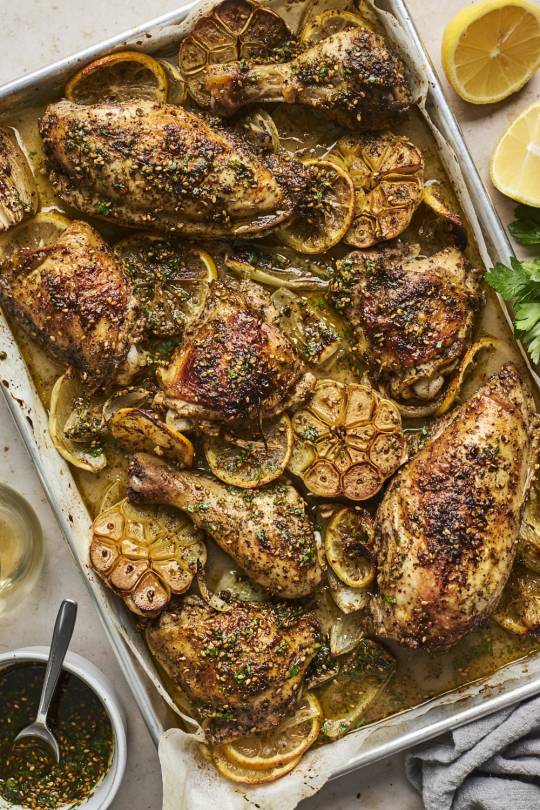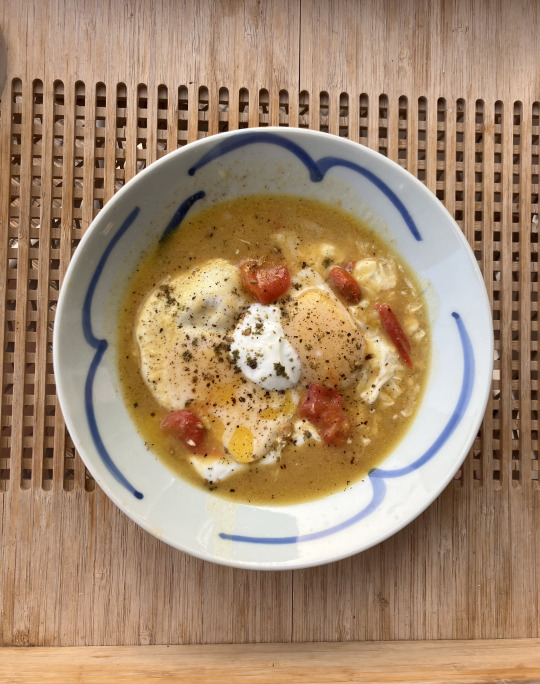#zaatar chicken
Explore tagged Tumblr posts
Photo

Recipe for Oven-Roasted Za'atar Chicken Breasts This tender and juicy za'atar-marinated chicken gets an extra dose of za'atar seasoning right before being roasted in the oven. Serve with couscous or roasted potatoes. 4 boneless skinless chicken breasts, 2 tablespoons olive oil, 3 tablespoons za'atar seasoning divided, cooking spray, 2 tablespoons lemon juice, salt to taste, 1 clove garlic minced
0 notes
Photo

Oven-Roasted Za'atar Chicken Breasts This tender and juicy za'atar-marinated chicken gets an extra dose of za'atar seasoning right before being roasted in the oven. Serve with couscous or roasted potatoes.
0 notes
Photo

Grilled Za'atar Chicken Recipe This easy grilled chicken recipe uses a homemade za'atar spice blend with dried herbs and spices for a great Middle Eastern flavor. 1.5 teaspoons sumac powder, 1/4 teaspoon dried marjoram, 2 tablespoons lemon juice, 1 pound boneless skinless chicken breasts butterflied, 1/2 teaspoon salt, 1/2 teaspoon dried thyme, 1/4 cup grapeseed oil, 1/4 teaspoon oregano, 2 teaspoons ground cumin, nonstick cooking spray, 1 teaspoon toasted sesame seeds
0 notes
Text


Za'atar Chicken (via Olive & Mango)
#gluten free#gf food#gluten free foods#dairy free#soy free#grain free#chicken#sumac#watch your premade seasonings#zaatar#middle eastern food#garlic#meals#olive&mango
12 notes
·
View notes
Text
Go buy yourself some Za'atar right tf now
Honestly I'm not kidding, it's gonna change your gddm life. I'm gonna try it on every savoury meal I make forever because I just made a roast chicken - coated it in garlic, Za'atar, and oil, and it's incredible.
It made the best chicken stock I've ever made in my life - I didn't add more, but I include the skin when making stock and I can't go back to Za'atar-less stock it's just so good.
I didn't expect the meat to taste of it, not really, maybe a little but I swear it's so tasty
All that to say go buy some, preferably from Zaytoun, cause the money is guaranteed to help Palestine
#free palestine#free gaza#free west bank#palestine#zaatar#Zaytoun#food#cooking#chicken#homemade#homemade food
6 notes
·
View notes
Text
Mahmut got me an absolutely brilliant Middle Eastern cookbook yesterday and I've already done a recipe from it that I can't provide a photo of because we've already eaten it
6 notes
·
View notes
Photo

Chicken Thigh - Baked Za'atar Chicken Thighs Simple za'atar and olive oil coating is applied to boneless, skinless chicken thighs before they are baked to perfection. Serve them with a side dish with a Middle Eastern influence, or try wrapping them.
0 notes
Photo

Za'atar Chicken Thighs This simple chicken dish's distinctive flavor comes from the Arabic spice blend za'atar. The oven is used to complete pan-roasted chicken thighs. 1 tablespoon extra-virgin olive oil, sea salt and freshly ground black pepper to taste, 3 tablespoons za'atar divided or more to taste, 4 bone-in chicken thighs with skin
0 notes
Photo

Baked Za'atar Chicken Thighs Simple za'atar and olive oil coating is applied to boneless, skinless chicken thighs before they are baked to perfection. Serve them with a side dish with a Middle Eastern influence, or try wrapping them.
0 notes
Photo

Baked Za'atar Chicken Thighs Simple za'atar and olive oil coating is applied to boneless, skinless chicken thighs before they are baked to perfection. Serve them with a side dish with a Middle Eastern influence, or try wrapping them.
0 notes
Photo

Za'atar Chicken Thighs The Arabic spice mix za'atar gives this easy chicken dish its unique flavor. Chicken thighs are pan-roasted and then finished in the oven.
1 note
·
View note
Photo

Meat and Poultry - Chicken Breast - Grilled Za'atar Chicken For a delicious Middle Eastern flavor, this simple grilled chicken recipe uses a homemade za'atar spice blend with dried herbs and spices.
0 notes
Text
Several years ago, I invited my new boyfriend to Yom Kippur at my aunt’s house. He didn’t need convincing – I think he adored my family early on – but to entice him further I made sure he knew what was on offer.
Bagels. Cream cheese. Lox.
Let’s just say he showed up on time. I knew my aunt would be thrilled when he devoured the pickled herring. (He earned similar accolades when he asked for seconds of gefilte fish at Passover.)
Jewish food, he says, is just a hop, skip and a jump from the Scandinavian food he grew up with. “It’s like the foods of my people. Foods of your people, foods of our people.”
Apart from being poetic, it was a very Jewish thing for him to say.
Now my husband, Brad is definitively non-Jewish by all religious standards. His father was raised in a big Irish Catholic family and his mother, raised in the Midwest, is of Scandinavian descent. He was the first non-Jewish person I’d met with his own proclivity for pickled fish and smoked salmon.
Among the items he always kept in his pantry — before he met me and still today — are tinned fish and Triscuits, often eaten as a meal. He and I have been on a year-long journey of finding the best “real rye bread” within driving distance in the greater Metrowest area of Boston. (Haven’t found it yet.)
To say that he embraces all things Jewish is obvious. That he loves me is only part of the reason; another is the food.
My grandmother always had enough food to feed an army, no matter whether it was Shabbat, Passover or Tuesday. I watched as Brad became accustomed to the foods we loved and the leftovers we take pride in sharing: the containers left on the table after Yom Kippur for extra brisket, the paper bags for challah and rugelach.
But he’s taught us about food, too. Our family text chain is called “Smashburgers Unite” because of my family’s newfound favorite meal, brought to us by my husband. A better cook than I (a generous understatement), he loves cooking projects.
At that point, my biggest cooking project I’d taken on was making latkes for Hanukkah.
It had been my job for years. I’d shove the potatoes in the Cuisinart, wring them out as best I could, and do my best guesswork with how much egg, matzah meal, onion and salt should go in. Then I’d stand at the stove and fry them, the kitchen filling with that wonderful greasy-spoon smell, as the rest of my family arrived. I laid them out as they were done, always in an inadvertent ombre from light to dark as the oil, and my patience, decreased.
So for Brad’s first Hanukkah with us, I told him — who once made a BBQ for 40 people with no help from anyone — that I (and, by proxy, he) was in charge of latkes.
“Cool,” he said. His indifference both alarmed and relieved me.
“It’s more work than you think,” I said.
I should have known he’d have better tricks for peeling massive amounts of Russet potatoes and draining their water (cheesecloth! The man I’m dating owns cheesecloth?!), adding cornstarch to help the eggs adhere better to the mix, and adding enough salt so they actually tasted good. He added seasonings like zaatar, onion powder and garlic powder. He showed me how to wait until all the oil – way more than I was used to adding for frying – was shimmering, and to be patient while each side cooked.
I think he wanted to add a shallot.
“It’s not traditional,” I said.
“So?” he said.
He had a point.
The latkes that year were a hit. My family made sure he knew that it was now his task for life. They were joking, but they were also serious.
I knew he was about to take this latke-making to the next level. On the way home, he thought up different flavor combinations, like adding dill and black pepper, and what if we fried them in schmaltz – we’d have to roast a chicken first; store-bought schmaltz wouldn’t cut it – and what if we added cayenne, and what if we used different root vegetables, like turnips and rutabagas, and what if made a sweet potato version?
I was exhausted just thinking about it. The latkes take a great deal of effort, and I don’t have the same love of cooking that Brad does. Where he sees opportunity, I see how long it will take to clean up.
Maybe we buy shredded potatoes, to make it easier? I suggested.
But no: Everything from scratch, no shortcuts. Our first year in our new home together, we made them in our kitchen. He shredded the potatoes, I wrung them out. He set up three bowls with different seasonings and spices. I spooned them into balls, and we’d take turns at the stove, frying, flipping, frying again. We ate several between us right away – impossible not to. Yes, it was an hours-long process. But the pride I felt at bringing them home, measured by the silence while people ate and ate, was unmatched.
I learned that the effort, the planning, the execution: it’s a way of showing love. The energy we put into the latkes as a team made me feel closer, somehow, to the holiday and to my Jewish roots.
That first meal of jointly-made latkes also included my mom’s brisket. Over dinner, the conversation turned to other traditional Jewish foods like corned beef and pastrami. Brad pointed out that they were both brisket, just made different – something we hadn’t really ever thought about.
He mentioned he could make a pastrami.
Our eyes widened.
“It’s just a matter of brining it…then smoking it…”
So we’re in charge of both now: latkes and pastrami.
33 notes
·
View notes
Text
Walked up the street to my favorite almost literal hole in the wall and ordered a manakish and they said do you want the spicy sauce and today I said sure why not and they gave me a little cup and it was almost certainly Tapatio and actually it goes great with zaatar and grilled chicken. There's still some good in this world, Mr. Frodo.
8 notes
·
View notes
Text

09/06/2024
ingredients: eggs, chicken broth, chicken fat, butter, mini tomatoes from my friends garden, garlic, tzatziki, black pepper, several year old zaatar from a palestinian market which someone once gave me as a souvenir from their travels
review: 9/10
queen of hell has returned with some frankly michelin star slop. i used chicken fat i retrieved from the bottom of my air fryer and butter to fry the tomatoes and garlic and then added chicken broth and sorta poached sorta fried these eggs. then put on the seasonings. extremely delicious when smashed together into a creamy texture and eaten with a spoon. would enjoy this even if i wasn't aspirating daily
5 notes
·
View notes